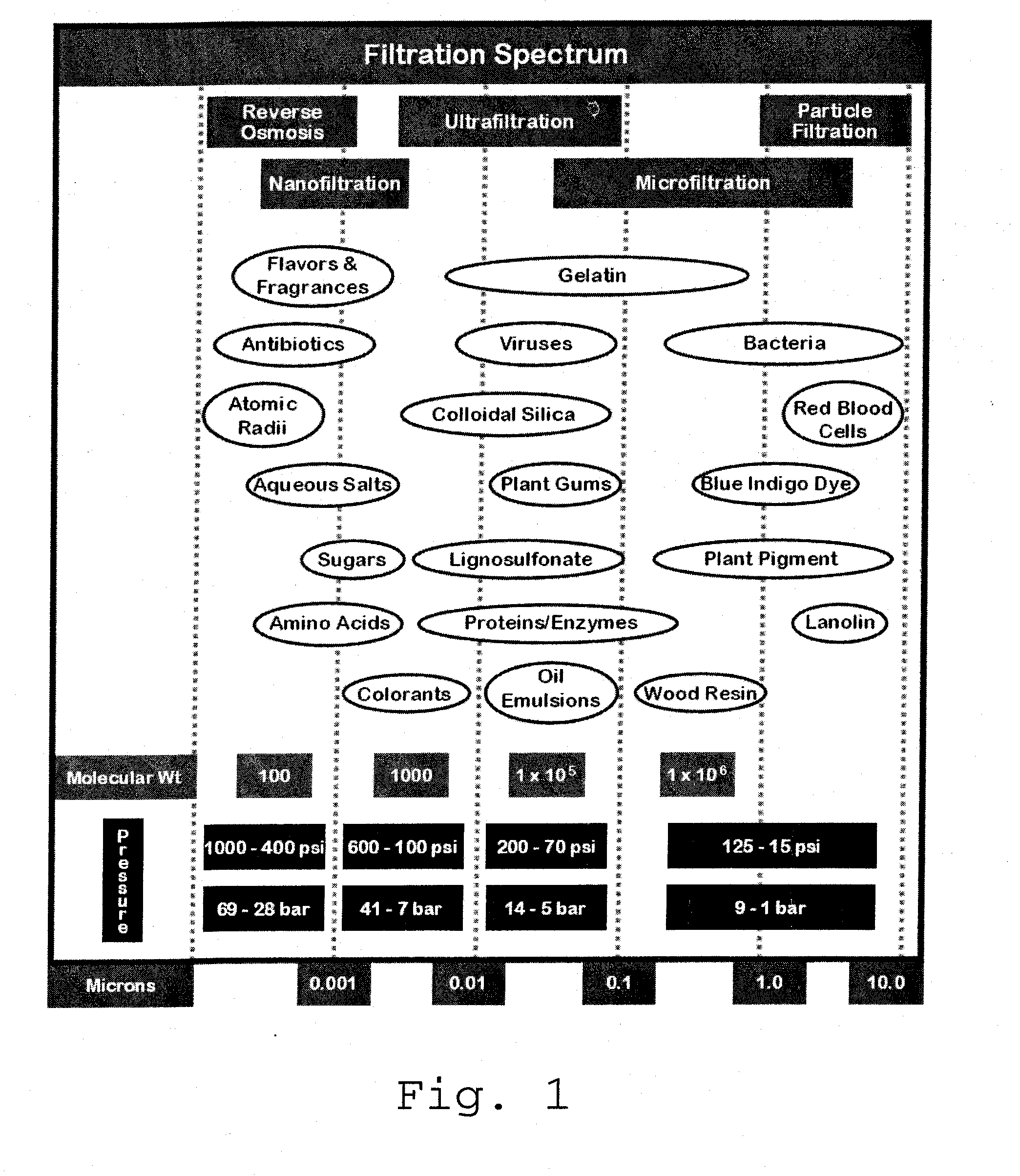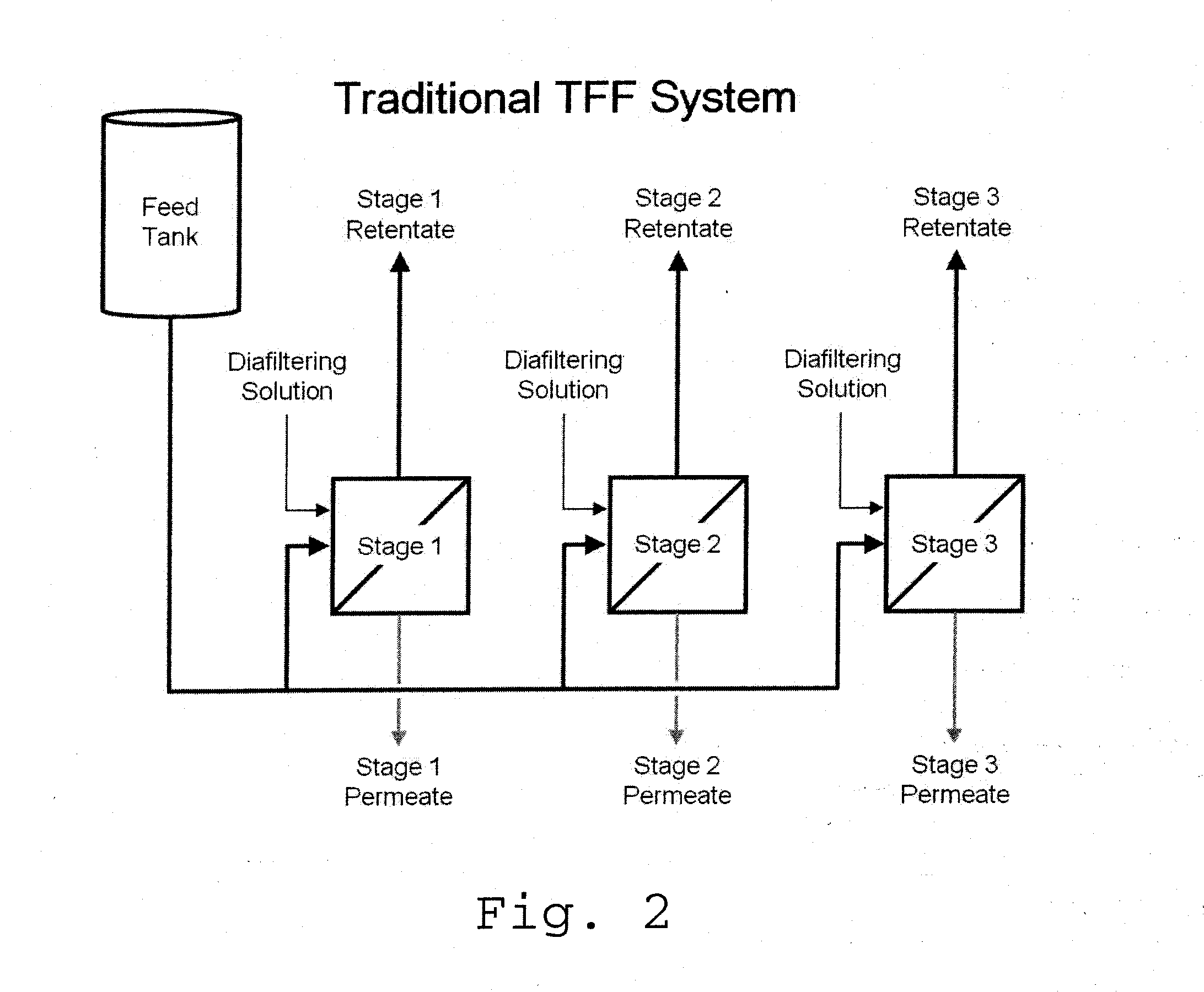Tangential Flow Filtration Apparatuses, Systems, and Processes for the Separation of Compounds
a tangential flow and filtration technology, applied in the field oftangential flow filtration apparatuses, systems, and processes for the separation of compounds, can solve the problems of increasing the risk of contamination of the product, increasing the cost of production, and increasing the risk of operators' contamination, so as to reduce the process steps and process raw material addition, the effect of high protein product yield and cost-effectiveness
- Summary
- Abstract
- Description
- Claims
- Application Information
AI Technical Summary
Benefits of technology
Problems solved by technology
Method used
Image
Examples
example 1
[0209]A set of experiments was conducted that demonstrated the advantage of the TFF microfiltration system during the microfiltration purification of glucoamylase enzyme from a fermentation broth composed of a mixture of corn steep solids, salts and a carbon nutrient. In the experiment, a Koch membrane module (Koch Systems, Wilmington, Mass.) Model MFK-601-FYT (8338) was used in this Example. A similar module was used in Examples 2 and 3 except for a smaller diameter (3838). The production host was Aspergillus niger. At the end of fermentation, the pH of the broth was adjusted to about pH 3.3 with sulfuric acid; 3.5% bentonite was added to the broth; and the broth was held for a minimum of 12 hours before beginning the microfiltration process. No water or diafiltration solution was added to the broth before the start of the clarification process, and no flocculants or filter aids were used for these experiments.
[0210]Compared to a traditional TFF system, the system of the applicatio...
example 2
[0213]Results in FIG. 6 was obtained with a conventional TFF system using a microfiltration membrane and a feed consisting of B. subtilis broth and protease enzyme. The results provide information concerning altering TMP and the effect on flux and passage of material through the membrane in a filtration unit (a simplified version of FIG. 2 with one stage).
[0214]FIG. 6 illustrates that for a product using low TMP pressures where traditional MF machines operate, the passage of the protein is sufficient to be able to operate up to about 0.9 bar TMP and have passages of 70% or above, with a flux rate of about 28 L / m2 / h (lmh) The TFF microfiltration apparatus / system described herein, however, could operate at a higher TMP of about 1.5 bar, and despite a passage of about 40%, could achieve over all yield of 90-92%, (see Example 1).
[0215]FIG. 7 provides another illustration of how the counter-current machine can provide a benefit. It shows data from three separate experiments demonstrating...
example 3
[0217]Table 1 lists several products that were obtained using the systems and methods described herein. These products made from either bacterial or fungal broth represent enzymes, each with unique properties although some may share similar enzymatic function and are said to be of a particular type, for example alpha-amylase #1 through #4. Various parameters used in obtaining the products are also listed herein.
TABLE 1Products and Production ParametersDelta PInlet sideInlet sideDiafiltration-(bar perfeed pressureexit pressureto-brothConcentrationProductelement)(bar)(bar)ratioratioAlpha-amylase #10.5-1.51.5-4.50.5-1.52.0-6.00.3-1.0Alpha-amylase #20.5-1.51.5-5.50.5-3.02.0-6.00.3-1.0Alpha-amylase #30.5-1.51.5-4.00.5-2.52.0-6.00.3-1.0Alpha-amylase #40.5-1.51.5-3.50.5-2.02.0-6.00.5-1.0Cellulase #10.5-1.51.5-3.50.5-2.02.0-6.00.3-1.0Cellulase #20.5-1.51.5-5.50.5-3.52.0-6.00.3-1.0Glucoamylase0.5-1.51.5-3.50.5-1.02.0-6.00.3-1.0Mannanase0.5-1.01.5-3.00.5-1.02.0-6.00.3-1.0Peroxidase0.5-1.01.5-...
PUM
| Property | Measurement | Unit |
|---|---|---|
| pressures | aaaaa | aaaaa |
| temperature | aaaaa | aaaaa |
| pH | aaaaa | aaaaa |
Abstract
Description
Claims
Application Information
 Login to View More
Login to View More - R&D
- Intellectual Property
- Life Sciences
- Materials
- Tech Scout
- Unparalleled Data Quality
- Higher Quality Content
- 60% Fewer Hallucinations
Browse by: Latest US Patents, China's latest patents, Technical Efficacy Thesaurus, Application Domain, Technology Topic, Popular Technical Reports.
© 2025 PatSnap. All rights reserved.Legal|Privacy policy|Modern Slavery Act Transparency Statement|Sitemap|About US| Contact US: help@patsnap.com



